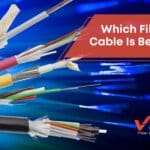
Small Cell as the Future of 5G Networks | V1 Fiber
Why Small Cell Fiber Is the Future of 5G Networks
5G networks rely on small cell fiber for lightning-fast, reliable data delivery. These small cell networks create the sophisticated infrastructure needed to realize the full spectrum of solid connections and ultra-high speeds. They can support up to a million devices per mile and connection times in milliseconds. Data from Statista suggests that U.S. 5G subscriptions will increase from 14.42 million in 2020 to 411 million by 2027.
How 5G Networks Differ From 4G Tech
5G small cell technology builds on the existing 4G network to maximize and expand upon its possibilities. The towers used for 4G networks are macrocells that send wireless signals at frequencies ranging from about 600 to 2,300 MHz. This technology provided the initial wave of mobile high-speed broadband in North America and most other regions.
Although these macrocell towers have long-range, high-power capabilities, they have a limited capacity to support 5G. Deploying a 5G network through the macrocell system increases latency (lag time) and degrades overall service.
Instead, 5G small cell technology uses millimeter wave (mmW) frequencies higher than 24 GHz. They support nationwide service through the use of three separate frequency bands.
Benefits of 5G Small Cell Technology
These small cell networks expand the available frequencies for 5G network sharing, eliminating lag and dramatically increasing connection and transfer speed. Unlike the macrocell networks, they have enough bandwidth to deliver the expected 5G performance even with unprecedented user demand.
Small cell towers also have a shorter range and use less power than their 4G counterparts. Providers use a high-density network structure that groups these towers in clusters to provide sufficient coverage. These combined 5G networks can provide the necessary network-sharing signal to entire cities and regions. Unlike large 4G towers, small cells fit on the sides of utility poles and buildings, so they’re a much more flexible and unobtrusive solution.
Considerations for Installation of Small Cell Networks
Companies can accelerate availability by installing fiber optic support for 5G. Professional engineers who specialize in 5G small cell technology will:
- Help you select an appropriate site for your network
- Recommend placement of small cells based on a comprehensive network traffic analysis
- Provide the necessary power supply and data connection for installation and network sharing
- Trench the fiber optic network cables
- Provide ongoing node maintenance for the network
Working with an experienced firm also ensures compliance with state and local regulations for 5G. For example, some municipalities have a cap on the number of small cell towers in a designated location. A thorough assessment can address possible hurdles for 5G small cell technology at your facility.
Professional assistance can also guide the planning of distinct networks for each provider where needed. You only need one small cell network if your organization uses a single wireless network carrier. Unlike with 4G, multiple providers in one location each require their own network.
Smart Solutions With 5G Smart Cell Technology
Innovative networks integrate additional state-of-the-art tech for improved access and bandwidth support. You can potentially use a “host” small cell as an agnostic carrier platform if you need multi-provider support. With this network-sharing structure, you can provide 5G access to the appropriate carriers to avoid redundancy and optimize the use of space.
Many businesses also create heterogenous 5G networks, colloquially called “HetNet.” These systems combine fiber-optic infrastructure, Wi-Fi networks, small cells, and macrocells into a coordinated solution that benefits from the diverse array of available tech. In this increasingly common scenario, 5G small cell technology bridges the service gaps users may otherwise experience.
Virtualization is also gaining traction in the 5G space, offering the capacity and performance to emulate hardware functions on software platforms. In this framework, users access virtual devices through 5G, which could expand speed and agility even further. Virtualization also supports seamless collaboration across small cell networks, which is a boom for businesses in our landscape of increased globalization.
Engage in the Future With 5G Networks
Regardless of how your company implements 5G small cell technology in your space, this innovation will serve as a cornerstone for advanced connectivity. Tests reveal speeds of up to 83.8 Mbps for these next-generation networks. V1 Fiber provides turnkey solutions for 5G networks with stable, speedy fiber optic support. Connect with us today to schedule a consultation or request a quote.
Sources:
https://www.wilsonpro.com/blog/small-cell-technology-the-future-of-5g
https://www.celona.io/5g-lan/5g-small-cell
https://www.telit.com/blog/5g-networks-guide-to-small-cell-technology/
https://www.thefoa.org/tech/ref/appln/SmallCells.html
https://www.statista.com/topics/7600/5g-in-the-united-states





No Comments
Sorry, the comment form is closed at this time.